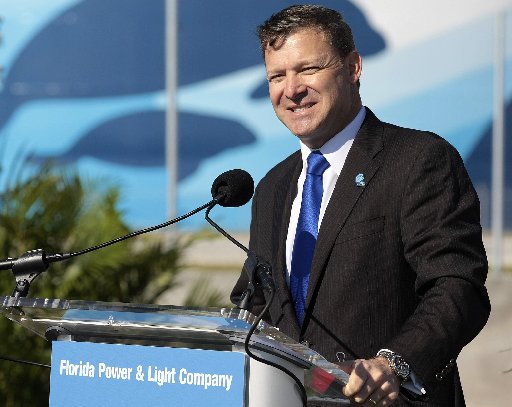
(Reuters) – Hurricane Irma threatens to knock out power to more than 4.1 million homes and businesses served by Florida Power & Light (FPL), affecting around nine million people based on the current storm track, the utility’s chief executive said on Friday.
“Everyone in Florida will be impacted in some way by this storm,” Eric Silagy said at a news conference, urging FPL customers to be prepared for a multiweek restoration process.
FPL is the biggest power company in Florida serving almost half of the state’s 20.6 million residents.
Outages across the state will likely top 4.1 million customers since other utilities, including units of Duke Energy Corp, Southern Co and Emera Inc, will also suffer outages but have not yet estimated how many.
Irma poses a significantly bigger menace to power supplies in Florida than Hurricane Harvey did in Texas because Irma is packing 150 mile-per-hour winds (240 km/h) that could down electric lines and close nuclear and other power plants.
“This storm is unprecedented as far as strength and size. We are preparing for the worst and will likely have to rebuild parts of our service territory,” Silagy said, noting the kinds of winds expected could snap concrete poles.
Irma’s winds have rivaled the strongest for any hurricane in history in the Atlantic, whereas Harvey’s damage came from record rainfall. Even as Houston flooded, the power stayed on for most, allowing citizens to use TV and radio to stay apprised of danger, or social media to call for help.
“When Harvey made landfall in Texas it made it fully inland and weakened pretty quickly. Irma, however, could retain much of its strength,” said Jason Setree, a meteorologist at Commodity Weather Group.
Irma has killed several people and devastated islands in the Caribbean.
Current forecasts put almost the entirety of the Florida peninsula in the path of the storm, which made landfall in the Caribbean with wind speeds of 185 mph.
The threat of the Category 4 storm, the second highest rung on the Saffir-Simpson Hurricane Wind Scale, is grave enough that FPL plans to shut its two nuclear power plants in the state, and officials warned that it may have to rebuild parts of its power system, which could take weeks.
One of those nuclear plants, Turkey Point, is located south of Miami near the southern tip of Florida, putting it near where Irma is expected to make landfall early Sunday morning. The other nuclear plant, St. Lucie, is on a barrier island on the east coast about 120 miles (193 km) north of Miami.
Most Florida residents have not experienced a major storm since 2005, when total outages peaked around 3.6 million during Hurricane Wilma. Some of those outages lasted for weeks.
Setree compared the projected path of Irma to Hurricane Matthew in 2016, which knocked out power to about 1.2 million FPL customers in October.
FPL, a unit of Florida energy company NextEra Energy Inc , restored service to most customers affected by Matthew in just two days.
In a statement this week, FPL estimated about half of its near five million customers – particularly in the trio of populous southeast counties Miami-Dade, Palm Beach and Broward – had not experienced a major hurricane since 2005.
FPL said it had invested nearly $3 billion since 2006 to strengthen its grid, including placing 60 main power lines underground and installing nearly five million smart meters and other devices.
Other utilities in the Sunshine State said in statements that they had also invested in intelligent, self-healing devices.
Smart meters allow utilities to see outages as they occur, rather than waiting on customer calls, and utilities also use automated devices that can reenergize lines without damage that were taken offline because of contact with trees or other objects, said Jay Apt, director of the Carnegie Mellon Electricity Industry Center in Pittsburgh.
Olivia Ross, a spokeswoman for CenterPoint Energy, which serves the greater Houston area, said these devices helped the utility keep the lights on for more people in the aftermath of Harvey as some issues were resolved remotely.
But such devices can only do so much. Harvey’s outages were limited to 312,000 customers, of which CenterPoint was responsible for about 109,000, as it quickly lost force after landfall and turned into a tropical storm. By contrast, Ross noted, Hurricane Ike in 2008 caused 2.1 million of CenterPoint’s customers to lose power when it hit the Texas coast near Houston.
